
Somali, officially the Federal Republic of Somalia and formerly known as the Somali Democratic Republic, is a country located in the Horn of Africa. The country was an important centre for commerce with the rest of the ancient world, and according to most scholars, it was the seat of ancient Land of Punt that thrived during bronze age. During the classic era until the Middle Ages, several powerful Somali states and port towns dominated the regional trade, including the Sultanate of Mogadishu and the Ajuran Sultanate, both centered around the port town of Mogadishu. Additionally, the port towns of Barawe and Merca played significant roles in this commercial network which were part of the Azania city states during classic era. Preceding these medieval states were ancient civilisations such as the legendary Macrobian Kingdom, noted by Herodotus for its wealth and wisdom, and the Barbario civilisation, an early pre-Islamic civilisation that helped lay the foundations for the region's prosperous trade routes.
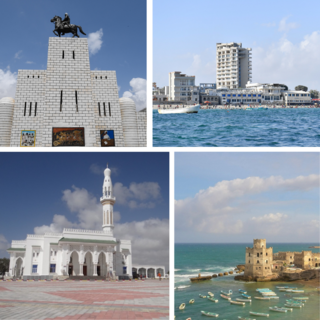
Mogadishu, locally known as Xamar or Hamar, is the capital and most populous city of Somalia. The city has served as an important port connecting traders across the Indian Ocean for millennia and has an estimated urban population of 2,610,483.

Italian Somaliland was a protectorate and later colony of the Kingdom of Italy in present-day Somalia, which was ruled in the 19th century by the Sultanate of Hobyo and Majeerteen in the north, and in the south by the political entities; Hiraab Imamate and the Geledi Sultanate.
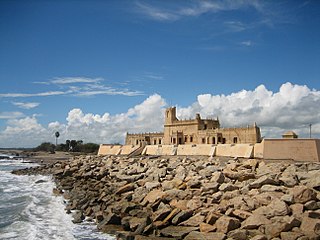
Colonial architecture is a hybrid architectural style that arose as colonists combined architectural styles from their country of origin with design characteristics of the settled country. Colonists frequently built houses and buildings in a style that was familiar to them but with local characteristics more suited to their new climate. Below are links to specific articles about colonial architecture, specifically the modern colonies:

The Catholic Church in Somalia is part of the worldwide Catholic Church, under the spiritual leadership of the Pope in Rome.
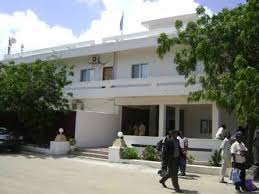
Villa Somalia in Mogadishu, is the palace and principal workplace of the president of Somalia. The current occupant of Villa Somalia is President Hassan Sheikh Mohamud (HSM) of the Federal Government of Somalia (FGS).

Christianity in Somalia is a minority religion within the country, which has a population over 99% Sunni Muslim, and Islam as the state religion. According to a 2020 report by the US Department of State, there are approximately 1,000 Christians in the nation.

The Trust Territory of Somaliland, officially the "Trust Territory of Somaliland under Italian administration", was a United Nations Trust Territory from 1950 to 1960, following the dissolution of the former British Military Administration. It was administered by Italy before gaining independence. It covered most of present-day Somalia and its capital was Mogadishu.

Italian Somalis are Somali-born citizens who are fully or partially of Italian descent, whose ancestors were Italians who emigrated to Somalia during the Italian diaspora, or Italian-born people in Somalia. Most of the Italians moved to Somalia during the Italian colonial period.
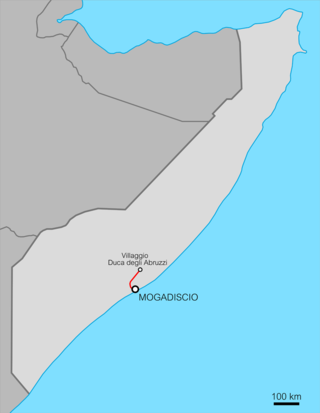
The Mogadiscio–Villabruzzi Railway is an historical railway system that ran through southern Somalia. It was constructed between 1914 and 1927 by the colonial authorities in Italian Somaliland. The railway connected the capital city Mogadishu with Afgooye, and subsequently with Villaggio Duca degli Abruzzi – usually called "Villabruzzi". The line was later dismantled by British troops during World War II. Plans for re-establishing the railway were made in the 1980s by the Siad Barre administration, but were aborted after the regime's collapse.

Railway transport in Somalia consisted of the erstwhile Mogadishu–Villabruzzi Railway and secondary tracks. The system was built during the 1910s by the authorities in Italian Somaliland. Its track gauge was 950 mm, a gauge favoured by the Italians in their colonies in the Horn of Africa and North Africa. The railway was dismantled in the 1940s by the British during their military occupation of Italian Somaliland, and was subsequently never rehabilitated.

Somali architecture is the engineering and designing of multiple different construction types such as stone cities, castles, citadels, fortresses, mosques, temples, aqueducts, lighthouses, towers and tombs during the ancient, medieval and early modern periods in Somalia and other regions inhabited by Somalis, as well as the fusion of Somalo-Islamic architecture with Western designs in contemporary times.
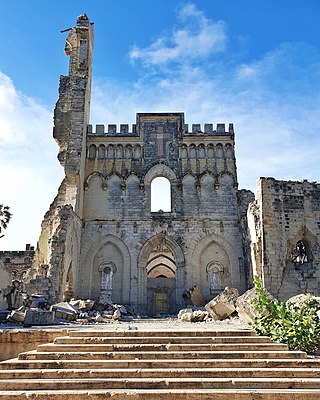
Mogadishu Cathedral is a ruined Catholic cathedral located in Mogadishu, Somalia. Between 1928 and 1991, it served as the seat of the Roman Catholic Diocese of Mogadiscio. Built in 1928 by Italian colonial authorities, much of the building was destroyed in 2008 by al-Shabaab. In 2013, the diocese announced plans to refurbish the building.

Somalia Governorate was one of the six governorates of Italian East Africa. It was formed from the previously separate colony of Italian Somalia, enlarged by the Ogaden region of the conquered Ethiopian Empire following the Second Italo-Ethiopian War.

Football in Somalia is run by the Somali Football Federation. The association administers the national football team, as well as the Premier League. Football is the most popular sport in Somalia.

The National Museum of Somalia is a national museum in Mogadishu, the capital of Somalia. It was established in 1933 by the colonial authorities in Italian Somaliland. After shutting down operations in 1991, it later reopened, and presently houses a number of important historical artifacts. In September 2019, the museum was rebuilt; almost 30 years after its destruction.
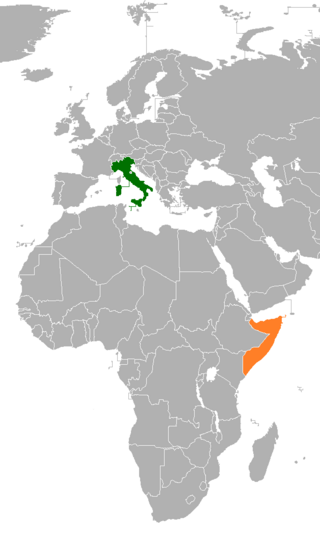
Italy–Somalia relations are bilateral relations between Italy and Somalia.

All railway stations in Italian Somaliland were served by the Mogadishu–Villabruzzi Railway of 114 kilometres (71 mi).

The Mogadiscio Circuit was formerly a car race through the main streets of Mogadiscio, Italian Somaliland, being first run in 1938.

The Petrella Airport was the first international airport in Italian Somalia. It was opened in 1928 -just 3 miles south of Mogadishu- with the name "Enrico Petrella" in honor of an Italian pilot who died a few years before in the same airport of Italian Mogadiscio. In 1941 the airport was partially destroyed during WW2 and remained inactive for some years as a civilian airport: only military airplanes used it. In 1950 was reopened as a civilian airport by the Italian authorities of the ONU Fiduciary Mandate.



















